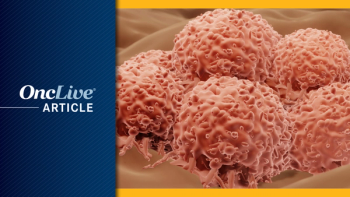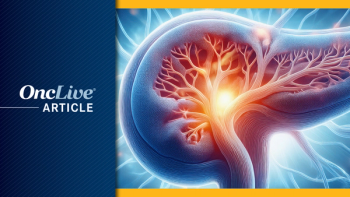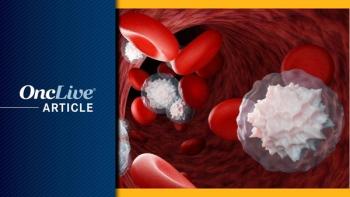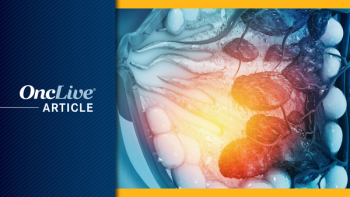
Long-Term Data Confirm Benefit of Erdafitinib in FGFR-Mutated Urothelial Carcinoma
The FGFR TKI erdafitinib continued to provide consistent clinical benefits with a manageable safety profile when used in the second-line treatment of patients with locally advanced or metastatic urothelial carcinoma harboring FGFR alterations.
The FGFR TKI erdafitinib (Balversa) continued to provide consistent clinical benefits with a manageable safety profile when used in the second-line treatment of patients with locally advanced or metastatic urothelial carcinoma harboring FGFR alterations, according to longer-term data from the phase 2 BLC2001 trial (NCT02365597) published in The Lancet.1
Results showed that at a median follow-up of 24.0 months (range, 22.7-26.6), with a median treatment duration of 5.4 months (range, 2.8-9.0), patients treated with the erdafitinib regimen achieved an objective response rate (ORR) of 40% (95% CI, 30%-49%; n = 40/101). These findings proved to be consistent with the ORR that was reported at the time of the primary analysis of the trial, which was 40% (95% CI, 30%-49%; n = 40/99).2
Additionally, the follow-up data indicated that 36% of the 40 responding patients experienced a partial response (PR) and 4% achieved a complete response (CR). Forty-one percent of patients had a best response of stable disease for at least 36 days, which translated to an overall disease control rate of 80% (95% CI, 72%-88%).
“Second-line erdafitinib treatment of patients with locally advanced or metastatic urothelial carcinoma and prespecified FGFR alterations showed consistent, durable clinical activity,” lead study author Arlene O Siefker-Radtke, MD, Department of Genitourinary Medical Oncology, Division of Cancer Medicine, of the University of Texas MD Anderson Cancer Center, and colleagues, wrote in the paper. “Erdafitinib remains an important treatment option for patients with locally advanced or metastatic urothelial carcinoma who progressed during or after 1 or more lines of previous platinum-based chemotherapy, including within 12 months of neoadjuvant or adjuvant platinum-based chemotherapy, and who have specific FGFR alterations.”
Over the past decade, limited therapeutic options have been available to patients with advanced urothelial carcinoma in whom frontline platinum-based chemotherapy has failed. However, in 2019, the
The trial enrolled patients who were at least 18 years of age and who had locally advanced and unresectable or metastatic urothelial carcinoma featuring at least 1 FGFR3 mutation, or FGFR2 or FGFR3 fusion. To be eligible for participation, patients must have had a history of disease progression during or after 1 or more lines of previous systemic chemotherapy, or within 12 months after neoadjuvant or adjuvant chemotherapy, or were ineligible for cisplatin due to impaired renal function or peripheral neuropathy and chemotherapy naïve.
Other eligibility criteria included having an ECOG performance status between 0 and 2, and adequate bone marrow, liver, and kidney function. Notably, patients who received any number of prior lines of therapy or who had previously received immunotherapy were eligible.
Patients were excluded if they had previously received chemotherapy, targeted therapies, definitive radiotherapy, or treatment with an investigational anticancer agent within 2 weeks prior to the first administration of study drug, had persistent serum phosphate concentration greater than the upper limit of normal within 14 days of treatment that could not be resolved through medical management, or if they had a history of or current uncontrolled cardiovascular disease.
Initially, participants were randomized 1:1 to receive either oral erdafitinib at a once-daily dose of 10 mg intermittently, on a 7-days-on and 7-days-off schedule or at a daily dose of 6 mg continuously in 28-day cycles. Findings from an interim analysis and pharmacokinetic and pharmacodynamic modeling based on clinical data prompted an amendment of the protocol to 8 mg daily given continuously with potential uptitration to 9 mg daily only (UpT dose schedule), converting the study into a single-group analysis.
In the selected 8 mg/day UpT regimen, uptitration to 9 mg daily was permitted on day 14 if patients did not experience adverse effects (AEs) that were related to treatment, or if they had not reached the target serum phosphate level of 5.5 mg/dL (1.8 mmol/L), a level associated with an improved response rate in the phase 1 study (NCT03473743).
Treatment was continued until disease progression or unacceptable AEs, as determined by the investigator. At the discretion of the investigator and the funder of the study, patients with investigator-assessed disease progression were able to continue treatment with erdafitinib.
The primary end point of the trial was confirmed ORR among those who received the selected dose regimen; CRs or PRs, which required confirmation within 4 to 6 weeks of the first assessment of response using RECIST v.1.1 criteria. Secondary end points included progression-free survival (PFS), duration of response (DOR), overall survival (OS), safety, response rate in biomarker-specific subgroups of FGFR translocations vs mutations, and pharmacokinetics.
Data from the primary analysis showed that at a median follow-up of 11.2 months (range, 8.2-15.6), the median OS was 13.8 months (95% CI, 9.8–not reached).
Of the 101 total patients who received treatment with erdafitinib, 60 patients received the agent at 8 mg and 41 received it at 9 mg.
Among the 101 participants, the median age was 67 years (range, 61-73), and 50% had an ECOG performance status of 0. Moreover, 88% of patients had progressed or relapsed after chemotherapy, 12% were chemotherapy naïve, and 24% received prior immunotherapy. Ten percent of patients did not receive any prior lines of therapy, 48% received 1 prior line, 28% received 2 prior lines, and 15% received 3 or more prior lines of treatment.
Seventy-seven percent of patients had present visceral metastases, and the primary tumor location was on the lower tract in 75% of patients. A FGFR mutation was present without a fusion in 69% of patients, the presence of a FGFR fusion without a mutation was observed in 25% of patients, and 6% had both a FGFR mutation and a fusion present.
Additional follow-up data showed that 77% of the 99 patients who received the 8 mg/day UpT regimen and who had undergone at least 1 disease evaluation after baseline experienced a reduction in the sum of target lesion diameters; notably, 48% of patients experienced a maximum tumor diameter reduction ranging from 30% to 100%.
Findings from prespecified subgroup analyses of ORR indicated that similar responses to erdafitinib were experienced, irrespective of whether visceral metastases were present. The median DOR among all 101 patients who received treatment was 6.0 months (95% CI, 4.2-7.5), with 31% of patients experiencing a response that persisted for at least 12 months.
Moreover, the median PFS with erdafitinib was 5.5 months (95% CI, 4.3-6.0), and the 12-month PFS rate was 21% (95% CI, 13%-29%). The median OS was 11.3 months (95% CI, 9.7-15.2), and the 12-month and 24-month OS rates were 49% (95% CI, 39%-59%) and 31% (95% CI, 22%-40%), respectively.
Findings from a post-hoc landmark analysis showed that at 3 months after treatment was started, PFS proved to be similar between those who responded vs those who did not; OS was improved among responders, although these data were limited due to small numbers.
Prespecified subgroup analyses revealed that those with an ECOG performance status of 0 or 1 experienced a longer median PFS vs those with a status of 2, at 5.6 months (95% CI, 5.0-6.8) vs 3.2 months (95% CI, 1.0-4.9), respectively; this was also true with regard to median OS, at 13.8 months (95% CI, 10.3-15.8) and 5.1 months (95% CI, 3.0-8.0), respectively.
Median DOR, PFS, and OS proved to be comparable among those with or without visceral metastases. Moreover, median DOR and OS proved to be generally similar between those with FGFR mutations and those with FGFR fusions, although median PFS appeared to be shorter in those with FGFR fusions vs those with FGFR mutations. Median PFS and OS was also noted to be comparable between those with hemoglobin concentrations of less than 10 g/dL and those with concentrations of 10 g/dL or greater at baseline.
“In our post-hoc subgroup analyses, PFS, OS, and DOR were not affected by factors such as age and sex, and most baseline disease characteristics, including hemoglobin level, primary tumor location, and renal function,” the study authors added.
The safety profile of the agent was consistent with what had been observed in the primary analysis. All patients experienced at least 1 AE, 59% of patients encountered treatment-related AEs that resulted in a dose reduction, and 16% had AEs that led to treatment discontinuation. Notably, no more than 2 patients reported the same AE that led to discontinuation. Moreover, 71% of patients experienced a grade 3 or 4 treatment-related AE, the most common of which were stomatitis (14%) and hyponatremia (11%).
Additionally, 53% of patients experienced grade 3 treatment-related AEs considered related to the 8-mg dose, although no grade 4 AEs that were experienced were related to erdafitinib. The most common treatment-emergent AEs of any grade included hyperphosphatemia (grade 1 or 2, 76%; grade 3, 2%), stomatitis (21% and 14%, respectively), diarrhea (50% and 4%), and dry mouth (45% and 1%).
Serious treatment-emergent AEs were reported in 45% of patients, with the most common being urinary tract infection and general physical health deterioration. Specifically, 11% of patients were considered by the investigator to be related to erdafitinib and no treatment-related deaths occurred.
The proportion of patients with central serous retinopathy, which is a known class effect of FGFR inhibitors and a treatment-emergent AE of special interest, was 27%. Specifically, 85% of instances of central serous retinopathy were grade 1 or 2. The median time to first onset of central serous retinopathy was 53 days (range, 32-100) for any grade and 94 days (range, 72-154) for grade 3 effects.
Erdafitinib is under investigation in further studies to weigh the agent’s efficacy in urothelial carcinomas.
“Further research, in a randomized, controlled, phase 3 study [NCT03390504] in patients with advanced urothelial cancer, is ongoing to evaluate erdafitinib as second-line monotherapy compared with a PD-1 inhibitor or chemotherapy,” study authors concluded. “Another [phase 3] study [NCT03473743] is ongoing to evaluate erdafitinib in combination with a PD-1 inhibitor [cetrelimab (JNJ-63723283)] in first-line treatment of patients with metastatic urothelial carcinoma who are ineligible for cisplatin.”
References
- Siefker-Radtke AO, Necchi A, Park SH, et al. Efficacy and safety of erdafitinib in patients with locally advanced or metastatic urothelial carcinoma: long-term follow-up of a phase 2 study. Lancet. Published online January 11, 2022. doi:10.1016/S1470-2045(21)00660-4
- FDA grants accelerated approval to erdafitinib for metastatic urothelial carcinoma. News release. FDA; April 12, 2019. Accessed January 25, 2022. https://bit.ly/32wNtyv

























































































